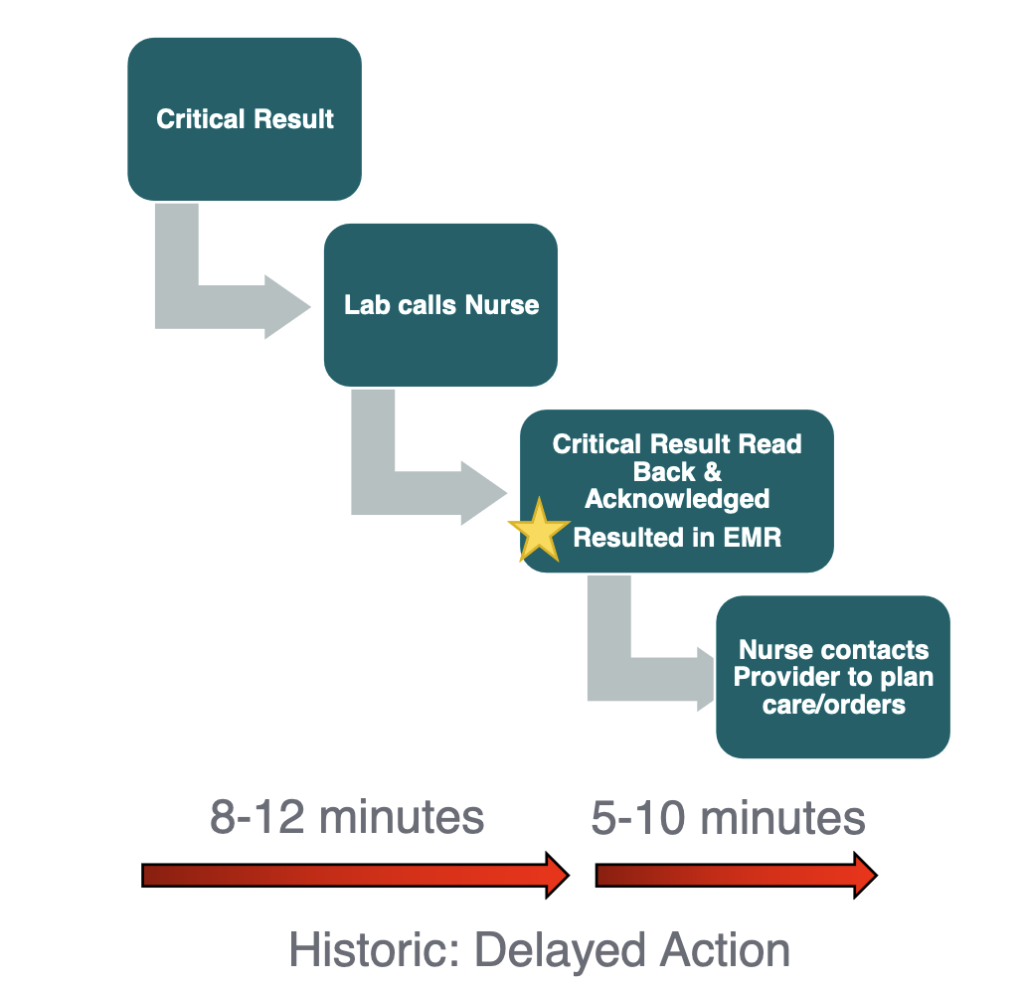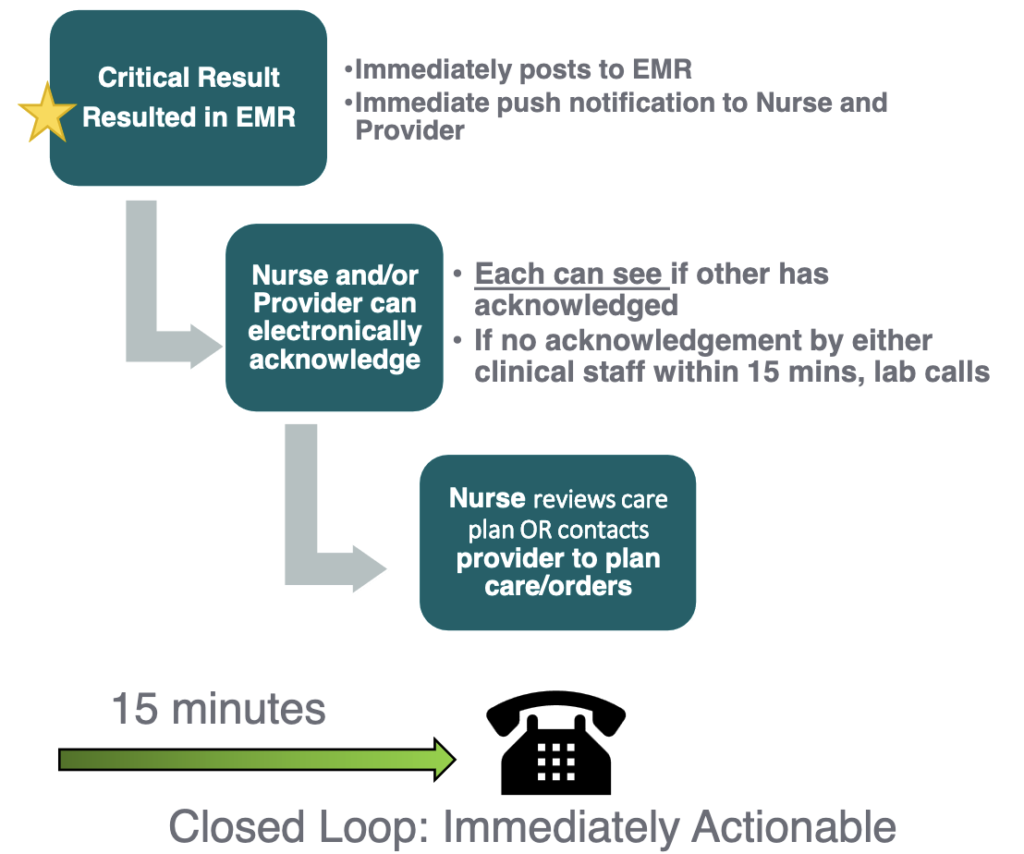Every year, Epic invites all their clients and potential future customers from across the world to attend the famous “User’s Group Meeting” (also known as UGM). UGM is where Epic unveils new products and discusses cool workflows other customers have implemented using Epic products to improve patient safety, increase physician efficiency, optimize billing, and much more. At this year’s UGM, one of the most talked-about features in Beaker is Closed-Loop Critical Result Acknowledgement. This workflow is live today at several health systems, and Epic is investing considerable resources to optimize it.
What are Closed-Loop Criticals?
The traditional practice of calling critical results to providers by phone has persisted for decades. However, this traditional method often leads to delayed action, as it requires the provider to be available when the laboratory makes the call. Often, multiple calls are necessary before the result can be communicated and released, delaying immediate care to patients. One of Honeydew’s clients in the Southeastern US implemented the closed-loop critical result communication workflow in a push to respond more quickly to patients’ critical results. This system leverages smartphone technology by delivering direct communication to providers through push notifications and In Basket messages. Providers can close the loop with the lab by acknowledging these notifications from mobile devices or several places in the patient chart, and the lab monitors a Follow-Up Work List to call any results not acknowledged by providers. Results are available and actionable immediately, and time is saved for lab and clinicians by reducing the number of phone calls needed.
Traditional Critical Call workflow vs. Closed-Loop Result Acknowledgement


Closed-Loop Result Acknowledgement Workflow: A closer view

- Lab tech reviews and verifies a critical result on a specimen.
- A Critical Result follow-up task is triggered automatically in the lab at final verification, which displays on the lab’s Follow-Up Work List (FUWL).
- The appropriate providers for the order are notified automatically of the critical result via an In Basket message and push notifications to Haiku/Canto.
- If a provider who is authorized to close the loop acknowledges the critical result, the result message is removed from In Basket, the lab follow-up task closes, and result acknowledgement is complete.
- Critical results can be acknowledged/reviewed either in In Basket messages, Haiku/Canto, or various lab result reports within Hyperspace.
- If an appropriate provider does not acknowledge the result within 15 minutes, the lab will call the provider to communicate the critical result and document that call on the Comm Log. Rows will become red on the FUWL after 15 minutes have passed since final verification.
Decision Points
There are many decision points requiring discussion with hospital operations and end-users to set appropriate expectations.
- Recipient of Push Notifications: Our client shifted from both Attending and Authorizing providers to targeting roles like First Contact (IP) and RNs actively on the treatment team for push notifications to ensure that the provider on call receives the notification. Epic recommends only send push notifications to users who are authorized to close the loop.
- Treatment Team Role Updates: The reliability of treatment team role updates and considerations for multi-person care teams are crucial factors in determining who receives critical result notifications.
- Behavior for Requisitions and OP Results: Our client decided not to implement closed-loop critical results acknowledgement for these results since the patient may no longer be physically present and the treatment team relationships could not be leveraged.
- Timing on the FUWL: Our client configured Epic so that follow-up tasks turn red 15 minutes following final verification.
- Auto-Verification of Critical Results: Consider whether to auto-verify critical results for specific sections or all sections, with our client opting for the latter.
- Prelim vs. Final Verification: Our client opted for using this workflow for ALL final verified criticals as well as prelim-verified critical gram stains and hemograms.
- Reviewing the FUWL: At our client’s hospital labs, each lab reviews its own closed-loop criticals FUWL (filtering by testing section), but is considering moving to a centralized CRM-style model.
- Regulatory Compliance: This depends on how each organization interprets CAP, Joint Commission, and ISO guidelines. Our client reviewed the following guidelines to confirm that this new workflow is compliant:
- College of American Pathologists: COM.30000 Critical Result Notification
- The Joint Commission “2023 Hospital National Patient Safety Goals”: NPSG.02.03.01
- International Organizations for Standards: ISO 15189
Limitations
Closed-Loop Result Acknowledgement is a relatively new workflow and there are limitations that Epic is currently both aware of as well as addressing (as of 4/25/2023).
- Messages not retracted once acknowledged/comm logged: If one user acknowledges a result, or if the lab has completed a comm log, messages are not “retracted” or completed for other clinicians who received a message/push notification for a specific result.
- Collection User functionality in Facility Record: The collection user functionality in the facility record is supposed to give the lab a button for each listed treatment team role in the Comm Log. For instance, if a patient has a First Contact provider on their treatment team, ideally the lab would see that user’s name and information in the Comm Log and be able to easily select. However, in order for this to work, the user must be “signed in” for the patient, which isn’t available for providers in the same way as for nurses.
- Repeat call functionality in does not account for acknowledgement: The rule property “Has All Previous Critical Results Called” and the corresponding build on the component (LRR) only account for critical results called via comm log and do not take into account result acknowledgement, requiring complex (and yet untested) workarounds.
- Visibility: A longstanding Beaker issue over the years has been add-ons not being visible enough to end users; the issue is even worse for FUWL tasks that are “due” – there’s nowhere to show techs that there’s a call that now needs to be made.
- Buried ED in-Hyperspace acknowledgment: The ED generates the majority of critical results and should be a huge beneficiary of this workflow. Unfortunately the re-design of the Side-by-Side Trackboard for their providers a few releases ago did not easily accommodate Closed-Loop Criticals – there’s not an place for them to acknowledge a critical result with one-click from the Trackboard.
- Smarter result routing: Epic needs to develop smarter Result Routing logic to be able to accommodate tiered scenarios such as “Send push notification to First Contact provider; if patient has no First Contact provider, send to Attending Provider; if no Attending Provider, send to authorizing provider”. Currently this is not technically possible.
Our Honeydew consultants have not only pioneered this new frontier of disrupting existing practices, but also helped drive the adoption and future development of this new Epic feature. If you would like more information on our experience with both implementing and supporting Closed-Loop Critical Result Acknowledgment, reach out to us at [email protected].
